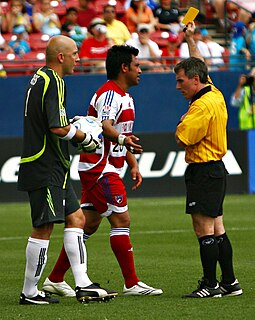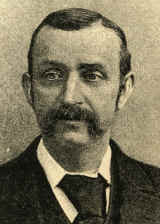Related Research Articles

Handball is a team sport in which two teams of seven players each pass a ball using their hands with the aim of throwing it into the goal of the other team. A standard match consists of two periods of 30 minutes, and the team that scores more goals wins.

A referee is an official, in a variety of sports and competition, responsible for enforcing the rules of the sport, including sportsmanship decisions such as ejection. The official tasked with this job may be known by a variety of other titles depending on the sport, including umpire, judge, arbiter (chess), commissaire, or technical official. Referees may be assisted by umpires, linesmen, timekeepers, or touch judges.

In the sport of association football, the referee is the person responsible for interpreting and enforcing the Laws of the Game during a match. The referee is the final decision-making authority on all facts connected with play, and is the match official with the authority to start and stop play and impose disciplinary action against players and coaches during a match.
An umpire in field hockey is a person with the authority to make decisions on a hockey pitch in accordance with the rules of the game. Each match is controlled by two such umpires. In theory they are responsible for decisions taken on their respective half of the field, but practically they 'control' on either diagonal half of the field. In many higher-level events, a reserve umpire is appointed in addition to the two field umpires to act as a back-up in the event of injury or other issue preventing a field umpire from commencing or continuing a match. In World-Level competitions, a video umpire is also appointed in addition to the field and reserve umpires.

In ice hockey, an official is a person who has some responsibility in enforcing the rules and maintaining the order of the game. There are two categories of officials, on-ice officials, who are the referees and linesmen that enforce the rules during gameplay, and off-ice officials, who have an administrative role rather than an enforcement role.

Gameplay in American football consists of a series of downs, individual plays of short duration, outside of which the ball is dead or not in play. These can be plays from scrimmage – passes, runs, punts, or field goal attempts – or free kicks such as kickoffs and fair catch kicks. Substitutions can be made between downs, which allows for a great deal of specialization as coaches choose the players best suited for each particular situation. During a play, each team should have no more than 11 players on the field, and each of them has specific tasks assigned for that specific play.

In gridiron football, an official is a person who has responsibility in enforcing the rules and maintaining the order of the game.

Ball badminton is a sport native to India. It is a racket game, played with a yellow ball made of wool, on a court of fixed dimensions divided by a net. The game was played as early as 1856 by the royal family in Tanjore, the capital of Thanjavur district in Tamil Nadu, India. It enjoys the greatest popularity in India. Ball badminton is a fast-paced game; it demands skill, quick reflexes, good judgment, agility, and the ability to control the ball with one's wrist.
Phil Luckett is a retired official in the National Football League (NFL), having served from 1991 to 2005, and again in 2007. His officiating uniform number was 59. He entered the NFL as a field judge in 1991 and officiated Super Bowl XXXI, his last game at that position before he became a referee in 1997 after Red Cashion and Howard Roe announced their retirements. He also refereed in the WLAF/NFL Europe, including being assigned World Bowl '97. He returned to the NFL back judge position in 2001, three years after the NFL switched the titles of back judge and field judge. He took a leave of absence from the NFL for the 2006 season. In 2007, he returned to officiating as the back judge on Bill Carollo's crew and retired at the end of the season. After retiring, he was employed by the league as an officiating supervisor.

An umpire is an official in the sport of Australian rules football who adjudicates the game according to the "Laws Of The Game", the official handbook of Australian Rules Football.

In basketball, an official enforces the rules and maintains order in the game. The title of official also applies to the scorers and timekeepers, as well as other personnel that have an active task in maintaining the game. Basketball is regarded as among the most difficult sports to officiate due to the speed of play, complexity of rules, the case-specific interpretations of rules, and the instantaneous decision required.
The following is an alphabetical list of terms and jargon used in relation to Gaelic games. See also list of Irish county nicknames

In tennis, an official is a person who ensures that a match or tournament is conducted according to the International Tennis Federation Rules of Tennis and other competition regulations.

In association football, an assistant referee is an official empowered with assisting the referee in enforcing the Laws of the Game during a match. Although assistants are not required under the Laws, at most organised levels of football the match officiating crew consists of the referee and at least two assistant referees. The responsibilities of the various assistant referees are listed in Law 6, "The Other Match Officials". In the current Laws the term "assistant referee" technically refers only to the two officials who generally patrol the touchlines, with the wider range of assistants to the referee given other titles.
An official in Canadian football is a person who has responsibility in enforcing the rules and maintaining the order of the game, like their counterparts in the American game. In the Canadian Football League, seven officials operate on the field. Lower levels of play up to the university level use less than the standard seven.
The Hockey Canada Officiating Program is the governing body for on-ice officials for all ice hockey games played under the jurisdiction of Hockey Canada. The Hockey Canada Rulebook provides in-depth explanation and examples of all rules governing hockey in Canada.

Rugby league match officials are responsible for fairly enforcing the Laws of the Game from a neutral point of view during a match of rugby league football and imposing penalties for deliberate breaches of these Laws. The most senior match official is the referee. They may be assisted by a range of other officials depending on the level and rules of the competition.

Rugby union match officials are responsible for enforcing the rugby union laws of the game during a match and imposing sanctions on individuals who do not follow the rules. "Every match is under the control of match officials who consist of the referee and two touch judges or assistant referees." Further officials can be authorised depending on the level and form of the game.

The rules of water polo are the rules and regulations which cover the play, procedure, equipment and officiating of water polo. These rules are similar throughout the world, although slight variations do occur regionally and depending on the governing body. Governing bodies of water polo include FINA, the international governing organization for the rules; the NCAA, which govern the rules for collegiate matches in the United States; the NFHS, which govern the rules in high schools in the USA; and the IOC, which govern the rules at Olympic events.

The NRL Touch Premiership is the premier national domestic touch football competition in Australia. It was formed in 2018, through a partnership between its governing body, Touch Football Australia (TFA), and the National Rugby League (NRL). The premiership includes a separate men's and women's competition, and features elite touch football players from around Australia, many of which are current Australian representatives.
References
- 1 2 "Playing Rules, 4th Edition". Federation of International Touch. Retrieved 31 January 2013.
- ↑ "International Uniform Policy". Federation of International Touch. p. 2. Retrieved 31 January 2013.
- ↑ "Section 2". Referees Policy & Procedures Manual. Touch Football Australia. Retrieved 31 January 2013.
- ↑ "touchnz.co.nz/index.php?id=16&tx_ttnews%5Btt_news%5D=238&tx_ttnews%5BbackPid%5D=17&cHash=a2c6b65e2a". Touch NZ. Retrieved 31 January 2013.